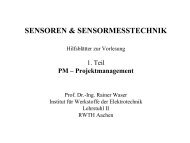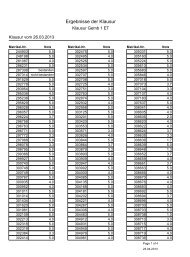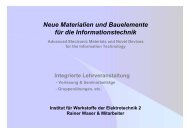Sensors and Sensor Measurement Techniques I Description of ...
Sensors and Sensor Measurement Techniques I Description of ...
Sensors and Sensor Measurement Techniques I Description of ...
Create successful ePaper yourself
Turn your PDF publications into a flip-book with our unique Google optimized e-Paper software.
<strong><strong>Sensor</strong>s</strong> <strong>and</strong> <strong>Sensor</strong> <strong>Measurement</strong> <strong>Techniques</strong> I<br />
<strong>Description</strong> <strong>of</strong> Contents<br />
The need for sensors is steadily increasing in modern technologies. Manifold sensor<br />
applications are found in the fields <strong>of</strong> environmental technology, production<br />
engineering, automotive industry, <strong>and</strong> medical technology.<br />
The lecture focuses on theoretical fundamentals, working principles, <strong>and</strong> applications<br />
<strong>of</strong> the relevant sensor classes. Based on dedicated examples, some state-<strong>of</strong>-the-art<br />
topics are emphasized. Selected concepts <strong>of</strong> circuit technology, e.g. the concept <strong>of</strong><br />
charge amplifiers, phase-sensitive rectification, <strong>and</strong> the lock-in analyzer technique<br />
are used as examples to give an introduction into the sensor measurement<br />
techniques <strong>and</strong> signal processing.<br />
The schedule includes 13 dates each <strong>of</strong> 90 minutes lecture followed by 45 minutes<br />
exercise corresponding to 5 ECTS credits which are attained if the final examination<br />
is passed. The language is German.<br />
Syllabus<br />
Chapter 1: <strong><strong>Sensor</strong>s</strong> as system components<br />
• <strong>Sensor</strong> characteristics (nonlinearities, hysteresis, cross sensitivity)<br />
• Transfer characteristics, sensor response<br />
Chapter 2: Temperature sensors<br />
• Thermoelectric sensors, thermocouples<br />
• Resistive sensors, semiconductor theory,<br />
pn-transitions, grain boundaries, thermistors<br />
• Quartz crystal sensor<br />
• Pyroelectric detectors, thermodynamics <strong>and</strong> theory,<br />
application in “infrared eyes”<br />
Chapter 3: Force <strong>and</strong> pressure sensors<br />
• Piezo-resistive sensors, resistive strain gages<br />
• Piezoelectric sensors, theory <strong>of</strong> ferroelectrics<br />
• Capacitive, inductive <strong>and</strong> optical methods<br />
• Tactile sensors, touch screens, fingerprint sensors
Chapter 4: Magnetic field sensors<br />
• Geometrical magnetoresistance, anisotropic magnetoresistance, AMR<br />
sensors<br />
• Fluxgate sensor, phase-sensitive detection, lock-in amplifier<br />
• SQUIDs (superconducting quantum-interference devices)<br />
Chapter 5: Optical sensors<br />
• Photonic counters, light dependent resistors (LDRs), photo diodes;<br />
semiconductor physics<br />
• Charge accumulation <strong>and</strong> charge transfer elements, charge coupled<br />
devices (CCDs)<br />
• Time-<strong>of</strong>-flight principle<br />
Chapter 6: Chemical sensors<br />
• Resistive chemical sensors, sensors based on lattice defects,<br />
calorimetric sensors; thermodynamics <strong>and</strong> kinetics <strong>of</strong> lattice disorder<br />
<strong>and</strong> solid electrolyts<br />
• Electrochemical sensors <strong>and</strong> applications<br />
• ISFETs (ion sensitive field effect transistors)<br />
• Introduction into SAW/BAW sensors<br />
• “Electronic” noses with extremely high selectivity<br />
• <strong>Sensor</strong> arrays, “smart” sensors, adaptive concepts<br />
Exercises<br />
The supplemental exercises provide a basis to deepen <strong>and</strong> apply the subject matter,<br />
<strong>and</strong> prepare for the examination.<br />
Given tasks address the following topics:<br />
Use <strong>of</strong> oscillators in sensor measurement techniques, application examples <strong>of</strong><br />
operational amplifiers, linearization <strong>of</strong> sensor characteristics, temperature sensor<br />
KTY 83, NTC temperature sensors, physical working principles <strong>of</strong> PTC thermistors,<br />
dimensioning <strong>of</strong> PTC-thermistors as overload protection, transfer characteristics <strong>of</strong><br />
pyroelectric detectors, piezoelectric igniter, piezoelectric sensor, piezo-resistive strain<br />
gauges <strong>and</strong> Wheatstone bridges, principles <strong>of</strong> Permalloy AMR sensors, magnetic<br />
field sensor KMZ 10, lock-in amplifier, photometer, light dependent resistor (LDR),<br />
PIN-photodiode, time-<strong>of</strong>-flight sensor, CCDs, defect chemistry <strong>of</strong> SrTiO3, use <strong>of</strong><br />
electronic ceramics as oxygen sensors.<br />
Solutions <strong>of</strong> the tasks are presented <strong>and</strong> answers to additional multiple choice<br />
problems are discussed.








